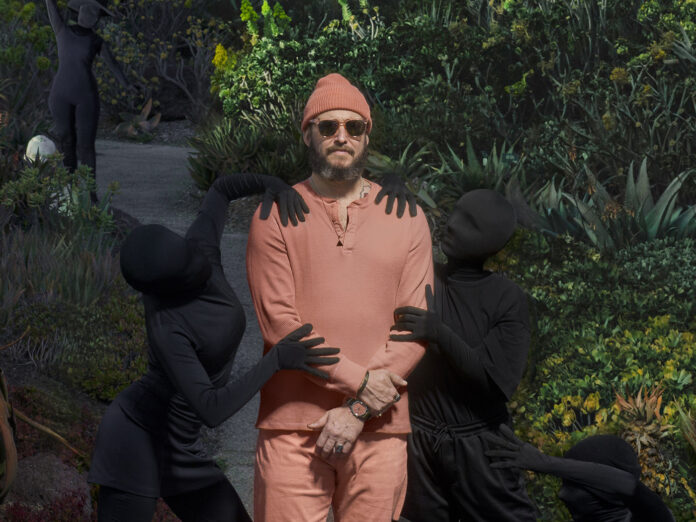Last autumn, the Wisconsin band Bon Iver released a new song named “Speyside”; a pared-back and rueful composition in which Justin Vernon’s voice clung only to guitar and pedal steel. It was an astonishing piece of songwriting, but its demeanour was familiar; many wondered whether it might signal a doubling-back to the folky and forlorn terrain of the band’s first album, For Emma, Forever Ago, after so many years in the experimental wilderness.
Last autumn, the Wisconsin band Bon Iver released a new song named “Speyside”; a pared-back and rueful composition in which Justin Vernon’s voice clung only to guitar and pedal steel. It was an astonishing piece of songwriting, but its demeanour was familiar; many wondered whether it might signal a doubling-back to the folky and forlorn terrain of the band’s first album, For Emma, Forever Ago, after so many years in the experimental wilderness.
Bon Iver is now a band of 18 years and five albums’ standing. Their shape and size has been fluid, and their output diverse. But their career to date has been a lesson in the unfaltering power of narrative. Not only was their 2007 debut a record of startling perfection, the story that accompanied its release – of a lovelorn songwriter retreating to a cabin in the Wisconsin woods to write a break-up record, was so beguiling, so thoroughly seductive, that for nearly two decades it has been hard to outrun.
After an absence of six years, SABLE, fABLE is not, in either mood or music, another For Emma…. Rather it is an album of great texture and variety, that directly addresses the weight of that sad troubadour reputation. It has been billed as “the epilogue” to the Bon Iver catalogue to date, with the faint suggestion that Vernon, who has no plans to tour these songs, could move on entirely.
The album falls into two parts. Sable is the record’s introspective half, made up of the three songs released on last year’s “Sable” EP. It is named for the darkest black, and opens with the track “Things Behind Things Behind Things”. “I would like the feeling/gone,” it begins, and pushes anxiously forward, pedal steel layered over tachycardiac drums, Vernon’s voice holding something strained and irretrievable. “Speyside” follows, along with “Awards Season”, a song that sets out plainly and moves through saxophone solo, choral backing, keys, to land somewhere tender. “I’m a sable,” he notes at one point. “And honey, us the fable.” It’s a classic Bon Iver line; perplexing on the page, profound in the singing.
The brief “Short Story” heralds the album’s second section, opening with a glimmer of keys, Vernon in falsetto, a haze of backing vocals. “Oh the vibrance!” it begins. “Sun in my eyes.” It is followed by “Everything Is Peaceful Love”, and its radiant and faintly goofy refrain – “Damn if I’m not climbing up a tree right now” gives the impression of the singer clambering towards the light.
Vernon wrote the track in late 2019. It was an unlikely song in many ways, synthy and smooth, and striking on something new: the feeling of burgeoning love, of contentment in a moment. “I put that song up on the shelf,” he said recently. “And I said, ‘I’m going to wait until other songs feel like that.’” It’s an interesting turn of phrase; over and again, SABLE, fABLE is an album that is felt as much as heard: the contraction of its opening tracks, the release of its love songs, the resolve of its closing numbers.
On 2016’s 22, A Million and 2019’s i, i, Vernon seemed to shroud himself in both music and language; increasing the cast and remit of the Bon Iver project, introducing layers of brass, voice filters, recording alongside dancers. He played with numerology, spellings, typesettings, capitalisation. He made his lyrics as opaque and imagistic as possible. He refused to be photographed without a face covering. The burden of being Mr Bon Iver was clearly, for a long time, unbearable.
Here, he’s writing more directly. At one point he quite literally calls a spade a spade. It’s a development that clearly reflects an emotional transition, and perhaps, the six years of deep collaboration, with everyone from his Big Red Machine counterparts, Aaron Dessner and Anais Mitchell, to pop behemoths such as Taylor Swift and Charli XCX. SABLE, fABLE also includes production from Jim-E-Stack and collaborations with Danielle Haim, as the Bon Iver sound marches further into something warmer, poppier.
The penultimate number, “There’s A Rhythm”, is the record’s slow-burn stand-out, opening with electric keys and building out over a steady percussion quite at odds to “Things Behind Things Behind Things”. “Can I feel another way?” Vernon asks, in another call back to the album opener.
The song brings a sense of quiet circularity not only to this record, but also to the entire Bon Iver narrative. If there’s a song that “There’s A Rhythm” most closely echoes – in sensation rather than sound, it’s surely “Re: Stacks”, the track that closed For Emma…. Both concern themselves with the healing power of rhythmic movement, of work to do, of process, leaving the listener with a sense of openness.
When SABLE, fABLE moves to its final track, “Au Revoir”, it is a small surprise to find it a short, wordless improvisation, piano-led and dappling. But there is something about it that makes sense; as Vernon put it all those years ago: “It’s the sound of the unlocking, and the lift away.”
When you purchase through links on our site, we may earn an affiliate commission. Here’s how it works.



